First Aid for Soldiers FM 21-11
FM 21-11 First Aid for Soliders: Chapter 6
First Aid for Bites and Stings
Headquarters, Department of the Army, Washington, D.C., October 27, 1988
INTRODUCTION
Snakebites, insect bites, or stings can cause intense pain and/or swelling. If not treated
promptly and correctly, they can cause serious illness or death. The severity of a
snakebite depends upon: whether the snake is poisonous or nonpoisonous, the type of snake,
the location of the bite and the amount of venom injected. Bites from humans and other
animals such as dogs, cats, bats, raccoons, and rats can cause severe bruises and
infection, and tears or lacerations of tissue. Awareness of the potential sources of
injuries can reduce or prevent them from occurring. Knowledge and prompt application of
first aid measures can lessen the severity of injuries from bites and stings and keep the
soldier from becoming a serious casualty.
6-1. Types of Snakes
a. Nonpoisonous Snakes. There are approximately 130 different varieties of
nonpoisonous snakes in the United States. They have oval-shaped heads and round eyes.
Unlike poisonous snakes, discussed below, nonpoisonous snakes do not have fangs with which
to inject venom. See Figure 6-1 for characteristics of a
nonpoisonous snake.
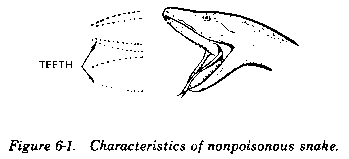
b. Poisonous Snakes. Poisonous snakes are found throughout the world,
primarily in tropical to moderate climates. Within the United States, there are four
kinds: rattlesnakes, copperheads, water moccasins (cottonmouth), and coral snakes.
Poisonous snakes in other parts of the world include sea snakes, the fer-de-lance, the
bushmaster, and the tropical rattlesnake in tropical Central America; the Malayan pit
viper in the tropical Far East; the cobra in Africa and Asia; the mamba (or black mamba)
in Central and Southern Africa; and the krait in India and Southeast Asia. See Figure 6-2 for characteristics of a poisonous pit viper.
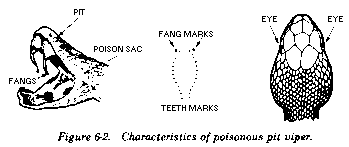
c. Pit Vipers (Poisonous). See Figure 6-3 for
illustrations.

(1) Rattlesnakes, bushmasters, copperheads, fer-de-lance, Malayan pit vipers, and water
moccasins (cottonmouth) are called pit vipers because of the small, deep pits between the
nostrils and eyes on each side of the head (Figure 6-2). In
addition to their long, hollow fangs, these snakes have other identifying features: thick
bodies, slit-like pupils of the eyes, and flat, almost triangular-shaped heads. Color
markings and other identifying characteristics, such as rattles or a noticeable white
interior of the mouth (cottonmouth), also help distinguish these poisonous snakes. Further
identification is provided by examining the bite pattern of the wound for signs of fang
entry. Occasionally there will be only one fang mark, as in the case of a bite on a finger
or toe where there is no room for both fangs, or when the snake has broken off a fang.
(2) The casualty's condition provides the best information about the seriousness of the
situation, or how much time has passed since the bite occurred. Pit viper bites are
characterized by severe burning pain. Discoloration and swelling around the fang marks
usually begins within 5 to 10 minutes after the bite. If only minimal swelling occurs
within 30 minutes, the bite will almost certainly have been from a nonpoisonous snake or
possibly from a poisonous snake which did not inject venom. The venom destroys blood
cells, causing a general discoloration of the skin. This reaction is followed by blisters
and numbness in the affected area. Other signs which can occur are weakness, rapid pulse,
nausea, shortness of breath, vomiting, and shock.
d. Corals, Cobras, Kraits, and Mambas. Corals, cobra, kraits and mambas all
belong to the same group even though they are found in different parts of the world. All
four inject their venom through short grooved fangs, leaving a characteristic bite
pattern. See Figure 6-4 for illustration of a cobra snake.
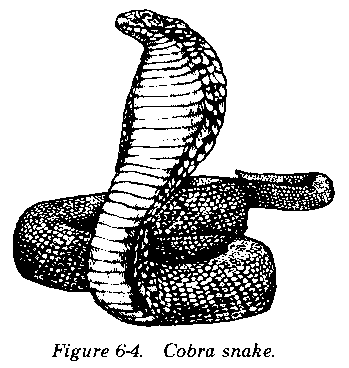
(1) The small coral snake, found in the Southeastern United States, is brightly colored
with bands of red, yellow (or almost white), and black completely encircling the body (Figure 6-5). Other nonpoisonous snakes have the same coloring, but
on the coral snake found in the United States, the red ring always touches the yellow
ring. To know the difference between a harmless snake and the coral snake found in the
United States, remember the following:
"Red on yellow will kill a fellow, Red on black, venom will
lack."

(2) The venom of corals, cobras, kraits, and mambas produces symptoms different from
those of pit vipers. Because there is only minimal pain and swelling, many people believe
that the bite is not serious. Delayed reactions in the nervous system normally occur
between 1 to 7 hours after the bite. Symptoms include blurred vision, drooping eyelids,
slurred speech, drowsiness, and increased salivation and sweating. Nausea, vomiting,
shock. respiratory difficulty, paralysis, convulsions, and coma will usually develop if
the bite is not treated promptly.
e. Sea Snakes. Sea snakes (Figure 6-6) are found in
the warm water areas of the Pacific and Indian oceans, along the coasts, and at the mouths
of some larger rivers. Their venom is VERY poisonous, but their fangs are only 1/4 inch
long. The first aid outlined for land snakes also applies to sea snakes.

6-2. Snakebites
If a soldier should accidentally step on or otherwise disturb a snake, it will attempt
to strike. Chances of this happening while traveling along trails or waterways are remote
if a soldier is alert and careful. Poisonous snakes DO NOT always inject venom when they
bite or strike a person. However, all snakes may carry tetanus (lockjaw); anyone bitten by
a snake, whether poisonous or nonpoisonous, should immediately seek medical attention.
Poison is injected from the venom sacs through grooved or hollow fangs. Depending on the
species, these fangs are either long or short. Pit vipers have long hollow fangs. These
fangs are folded against the roof of the mouth and extend when the snake strikes. This
allows them to strike quickly and then withdraw. Cobras, coral snakes kraits, mambas, and
sea snakes have short, grooved fangs. These snakes are less effective in their attempts to
bite, since they must chew after striking to inject enough venom (poison) to be effective.
See Figure 6-7 for characteristics of a poisonous snakebite. In
the event you are bitten attempt to identify and/or kill the snake. Take it to medical
personnel for inspection/identification. This provides valuable information to medical
personnel who deal with snakebites. TREAT ALL SNAKEBITES AS POISONOUS.

a. Venoms. The venoms of different snakes cause different effects. Pit viper
venoms (hemotoxins) destroy tissue and blood cells. Cobras, adders, and coral snakes
inject powerful venoms (neurotoxins) which affect the central nervous system, causing
respiratory paralysis. Water moccasins and sea snakes have venom that is both hemotoxic
and neurotoxic.
b. Identification. The identification of poisonous snakes is very important
since medical treatment will be different for each type of venom. Unless it can be
positively identified, the snake should be killed and saved. When this is not
possible or when doing so is a serious threat to others, identification may sometimes be
difficult since many venomous snakes resemble harmless varieties. When dealing with
snakebite problems in foreign countries, seek advice, professional or otherwise, which may
help identify species in the particular area of operations.
*c. First Aid. Get
the casualty to a medical treatment facility as soon as possible and with minimum
movement. Until evacuation or treatment is possible, have the casualty lie quietly and not
move any more than necessary. The casualty should not smoke, eat, nor drink any fluids. If
the casualty has been bitten on an extremity, DO NOT elevate the limb; keep the extremity
level with the body. Keep the casualty comfortable and reassure him. If the casualty is
alone when bitten, he should go to the medical facility himself rather than wait for
someone to find him. Unless the snake has been positively identified attempt to kill it
and send it with the casualty. Be sure that retrieving the snake does not endanger anyone
or delay transporting the casualty.
* (1) If the bite is on an arm or leg,
place a constricting band (narrow cravat [swathe], or narrow gauze bandage) one to two
finger breadths above and below the bite (Figure 6-8). However,
if only one constricting band is available, place that band on the extremity between the
bite site and casualty's heart. If the bite is on the hand or foot,
place a single band above the wrist or ankle. The band should be tight enough to stop the
flow of blood near the skin, but not tight enough to interfere with circulation. In other
words, it should not have a tourniquet-like affect. If no swelling is seen, place
the bands about 1 inch from either side of the bite. If swelling is present, put the bands
on the unswollen part at the edge of the swelling. If the swelling extends beyond the
band, move the band to the new edge of the swelling. (If possible, leave the old band on,
place a new one at the new edge of the swelling, and then remove and save the old one in
case the process has to be repeated.) If possible, place an ice bag over the area of the
bite. DO NOT wrap the limb in ice or put ice directly on the skin. Cool the bite
area--do not freeze it. DO NOT stop to look for ice if it will delay evacuation and
medical treatment.
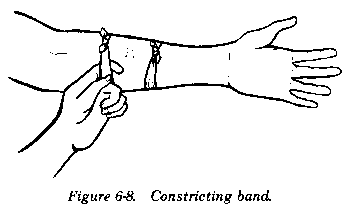
CAUTION
DO NOT attempt to cut open the bite nor suck out the venom. If the venom should
seep through any damaged or lacerated tissues in your mouth, you could immediately
lose consciousness or even die.
(2) If the bite is located on an arm or leg, immobilize it at a level below the heart.
DO NOT elevate an arm or leg even with or above the level of the heart.
CAUTION
When a splint is used to immobilize the arm or leg, take EXTREME care to ensure the
splinting is done properly and does not bind. Watch it closely and adjust it if any
changes in swelling occur.
(3) When possible, clean the area of the bite with soap and water. DO NOT use ointments
of any kind.
(4) NEVER give the casualty food, alcohol, stimulants (coffee or tea), drugs, or
tobacco.
(5) Remove rings, watches, or other jewelry from the affected limb.
NOTE
It may be possible, in some cases, for an aidman who is
specially trained and is
authorized to carry and use antivenin to administer it. The use of antivenin
presents special risks, and only those with specialized training should attempt to
use it!
d. Prevention. Except for a few species, snakes tend to be shy or passive.
Unless they are injured, trapped, or disturbed, snakes usually avoid contact with humans.
The harmless species are often more prone to attack. All species of snakes are usually
aggressive during their breeding season.
(1) Land snakes. Many snakes are active during the period from twilight to
daylight. Avoid walking as much as possible during this time.
-
Keep your hands off rock ledges where snakes are likely to be sunning.
-
Look around carefully before sitting down, particularly if in deep grass among rocks.
-
Attempt to camp on clean, level ground. Avoid camping near piles of brush, rocks, or
other debris.
-
Sleep on camping cots or anything that will keep you off the ground. Avoid sleeping on
the ground if at all possible.
-
Check the other side of a large rock before stepping over it. When looking under any
rock, pull it toward you as you turn it over so that it will shield you in case a snake is
beneath it.
-
Try to walk only in open areas. Avoid walking close to rock walls or similar areas where
snakes may be hiding.
-
Determine when possible what species of snakes are likely to be found in an area which
you are about to enter.
-
Hike with another person. Avoid hiking alone in a snake-infested area. If bitten, it is
important to have at least one companion to perform lifesaving first aid measures and to
kill the snake. Providing the snake to medical personnel will facilitate both
identification and treatment.
-
Handle freshly killed venomous snakes only with a long tool or stick. Snakes can
inflict fatal bites by reflex action even after death.
-
Wear heavy boots and clothing for some protection from snakebite. Keep this in mind when
exposed to hazardous conditions.
-
Eliminate conditions under which snakes thrive: brush, piles of trash, rocks, or logs
and dense undergrowth. Controlling their food (rodents, small animals) as much as possible
is also good prevention.
(2) Sea snakes. Sea snakes may be seen in large numbers but are not known to
bite unless handled. Be aware of the areas where they are most likely to appear and be
especially alert when swimming in these areas. Avoid swimming alone whenever possible.
WARNING
All species of snakes can swim. Many can remain under water for long periods. A bite
sustained in water is just as dangerous as one on land.
6-3. Human and Other Animal Bites
Human or other land animal bites may cause lacerations or bruises. In addition to
damaging tissue, human or bites from animals such as dogs, cats, bats, raccoons, or rats
always present the possibility of infection.
a. Human Bites. Human bites that break the skin may become seriously infected
since the mouth is heavily contaminated with bacteria All human bites MUST be
treated by medical personnel.
b. Animal Bites. Land animal bites can result in both infection and disease.
Tetanus, rabies, and various types of fevers can follow an untreated animal bite. Because
of these possible complications, the animal causing the bite should, if possible, be
captured or killed (without damaging its head) so that competent authorities can identify
and test the animal to determine if it is carrying diseases.
c. First Aid.
(1) Cleanse the wound thoroughly with soap or detergent solution.
(2) Flush it well with water.
(3) Cover it with a sterile dressing.
(4) Immobilize an injured arm or leg.
(5) Transport the casualty immediately to a medical treatment facility.
NOTE
If unable to capture or kill the animal, provide medical personnel with any information
possible that will help identify it. Information of this type will aid in appropriate
treatment.
6-4. Marine (Sea) Animals
With the exception of sharks and barracuda, most marine animals will not deliberately
attack. The most frequent injuries from marine animals are wounds by biting, stinging, or
puncturing. Wounds inflicted by marine animals can be very painful, but are rarely fatal.
a. Sharks, Barracuda, and Alligators. Wounds from these marine animals can
involve major trauma as a result of bites and lacerations. Bites from large marine animals
are potentially the most life threatening of all injuries from marine animals. Major
wounds from these animals can be treated by controlling the bleeding, preventing shock
giving basic life support, splinting the injury, and by securing prompt medical aid.
b. Turtles, Moray Eels, and Corals. These animals normally inflict minor
wounds. Treat by cleansing the wound(s) thoroughly and by splinting if necessary.
c. Jellyfish, Portuguese men-of-war, Anemones, and Others. This group of
marine animals inflict injury by means of stinging cells in their tentacles. Contact with
the tentacles produces burning pain with a rash and small hemorrhages on the skin. Shock,
muscular cramping, nausea, vomiting, and respiratory distress may also occur. Gently
remove the clinging tentacles with a towel and wash or treat the area. Use diluted ammonia
or alcohol, meat tenderizer, and talcum powder. If symptoms become severe or persist, seek
medical aid.
d. Spiny Fish, Urchins, Stingrays, and Cone Shells. These animals inject their
venom by puncturing with their spines. General signs and symptoms include swelling,
nausea, vomiting, generalized cramps, diarrhea, muscular paralysis, and shock. Deaths are
rare. Treatment consists of soaking the wounds in hot water (when available) for 30 to 60
minutes. This inactivates the heat sensitive toxin. In addition, further first aid
measures (controlling bleeding, applying a dressing, and so forth) should be carried out
as necessary.
CAUTION
Be careful not to scald the casualty with water that is too hot because the pain of the
wound will mask the normal reaction to heat.
6-5. Insect Bites/Stings
An insect bite or sting can cause great pain, allergic reaction, inflammation, and
infection. If not treated correctly, some bites/stings may cause serious illness or even
death. When an allergic reaction is not involved, first aid is a simple process.
In any case, medical personnel should examine the casualty at the earliest possible time.
It is important to properly identify the spider, bee, or creature that caused the
bite/sting especially in cases of allergic reaction when death is a possibility.
a. Types of Insects. The insects found throughout the world that can produce a
bite or sting are too numerous to mention in detail. Commonly encountered stinging or
biting insects include brown recluse spiders (Figure 6-9),
black widow spiders (Figure 6-10), tarantulas (Figure 6-11), scorpions (Figure 6-12),
urticating caterpillars, bees, wasps centipedes, conenose beetles (kissing bugs), ants,
and wheel bugs. Upon being reassigned, especially to overseas areas, take the time to
become acquainted with the types of insects to avoid.
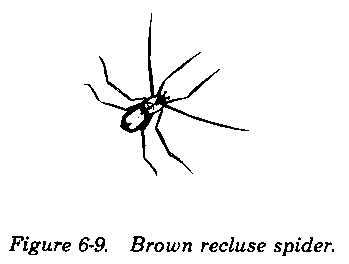
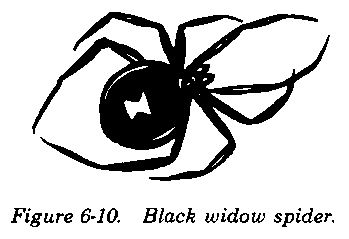
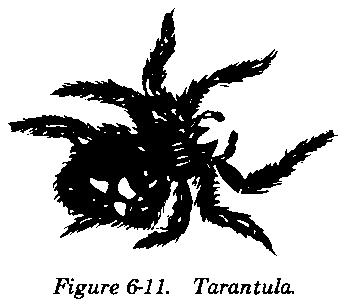
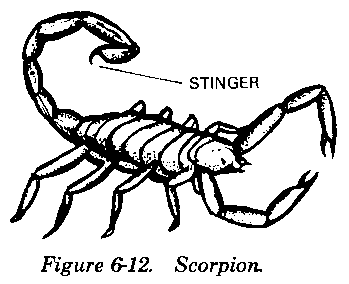
b. Signs/Symptoms. Discussed in paragraphs (1) and (2) below are the
most common effects of insect bites/stings. They can occur alone or in combination with
the others.
(1) Less serious. Commonly seen signs/symptoms are pain, irritation, swelling,
heat, redness, and itching. Hives or wheals (raised areas of the skin that itch) may
occur. These are the least severe of the allergic reactions that commonly occur from
insect bites/stings. They are usually dangerous only if they affect the air passages
(mouth, throat nose, and so forth), which could interfere with breathing. The bites/stings
of bees, wasps, ants, mosquitoes, fleas, and ticks are usually not serious and
normally produce mild and localized symptoms. A tarantula's bite is usually no worse than
that of a bee sting. Scorpions are rare and their stings (except for a specific
species found only in the Southwest desert) are painful but usually not dangerous.
(2) Serious. Emergency allergic or hypersensitive reactions sometimes result
from the stings of bees, wasps, and ants. Many people are allergic to the venom
of these particular insects. Bites or stings from these insects may produce more serious
reactions, to include generalized itching and hives, weakness, anxiety, headache,
breathing difficulties, nausea, vomiting, and diarrhea. Very serious allergic reactions
(called anaphylactic shock) can lead to complete collapse, shock, and even death. Spider
bites (particularly from the black widow and brown recluse spiders) can be serious also.
Venom from the black widow spider affects the nervous system. This venom can cause muscle
cramps, a rigid, nontender abdomen, breathing difficulties, sweating, nausea and vomiting.
The brown recluse spider generally produces local rather than system-wide problems;
however, local tissue damage around the bite can be severe and can lead to an ulcer and
even gangrene.
c. First Aid. There are certain principles that apply regardless of what
caused the bite/sting. Some of these are:
-
If there is a stinger present, for example, from a bee remove the stinger by scraping
the skin's surface with a fingernail or knife. DO NOT squeeze the sac attached to the
stinger because it may inject more venom.
-
Wash the area of the bite/sting with soap and water (alcohol or an antiseptic may also
be used) to help reduce the chances of an infection and remove traces of venom.
-
Remove jewelry from bitten extremities because swelling is common and may occur.
-
In most cases of insect bites the reaction will be mild and localized; use ice or cold
compresses (if available) on the site of the bite/sting. This will help reduce swelling,
ease the pain, and slow the absorption of venom. Meat tenderizer (to neutralize the venom)
or calamine lotion (to reduce itching) may be applied locally. If necessary, seek medical
aid.
-
In more serious reactions (severe and rapid swelling, allergic symptoms, and so forth)
treat the bite/sting like you would treat a snakebite; that is, apply constricting bands
above and below the site. See paragraph 6-2c(1) above
for details and illustration (Figure 6-8) of a constricting
band.
-
* Be prepared to perform basic lifesaving
measures, such as rescue breathing.
-
Reassure the casualty and keep him calm.
-
In serious reactions, attempt to capture the insect for positive identification;
however, be careful not to become a casualty yourself.
-
If the reaction of symptoms appear serious, seek medical aid immediately.
*CAUTION
Insect bites/stings may cause anaphylactic shock (a shock caused by a severe
allergic reaction). This is a life-threatening event and a MEDICAL EMERGENCY!
Be
prepared to immediately transport the casualty to a medical facility.
NOTE
Be aware that some allergic or hypersensitive individuals may carry identification
(such
as a MEDIC ALERT tag) or emergency insect bite treatment kits. If the casualty is
having an allergic reaction and has such a kit, administer the medication in the kit
according to the instructions which accompany the kit.
d. Prevention. Some prevention principles are:
-
Apply insect repellent to all exposed skin, such as the ankles to prevent insects from
creeping between uniform and boots. Also apply the insect repellent to the shoulder blades
where the shirt fits tight enough that mosquitoes bite through. DO NOT apply insect
repellent to the eyes.
-
Reapply repellent every 2 hours during strenuous activity and soon after stream
crossings.
-
Blouse the uniform inside the boots to further reduce risk.
-
Wash yourself daily if the tactical situation permits. Pay particular attention to the
groin and armpits.
-
Use the buddy system. Check each other for insect bites.
-
Wash your uniform at least weekly.
e. Supplemental Information. For additional information concerning biting
insects, see FM 8-230 and FM 21-10.
6-6. Table
See Table 6-1 for information on bites and stings.
Table 6-1. Bites and Stings
|
TYPES |
FIRST AID |
|
Snakebite |
1. Move the casualty away from the snake.
2. Remove all rings and bracelets from the affected extremity.
3. Reassure the casualty and keep him quiet.
4. Place ice or freeze pack, if available, over the area of the bite.
5. Apply constricting band(s) 1-2 finger widths from the bite. One should be able to
insert a finger between the band and the skin.
6. Immobilize the affected part in a position below the level of the heart.
7. Kill the snake (if possible, without damaging its head or endangering yourself) and
send it with the casualty.
8. Seek medical aid immediately.
|
|
Brown Recluse Spider or Black Widow Spider Bite |
1. Keep the casualty quiet.
2. Wash the area.
3. Apply ice or freeze pack, if available.
4. Seek medical aid. |
|
Tarantula Bite or Scorpion Sting or Ant Bites |
1. Wash the area.
2. Apply ice or freeze pack, if available.
3. Apply baking soda, calamine lotion, or meat tenderizer to bite site to relieve pain and
itching.
4. If site of bite(s) or sting(s) is on the face, neck (possible airway problems), or
genital area, or if local reaction seems severe, or if the sting is by the dangerous type
of scorpion found in the Southwest desert, keep the casualty quiet as possible and seek
immediate medical aid. |
|
Bee Stings |
1. If the singer is present, remove by scraping with a knife or fingernail. DO NOT
squeeze venom sac on stinger; more venom may be injected.
2. Wash the area.
3. Apply ice or freeze pack, if available.
*4. If allergic signs/symptoms appear, be prepared
to seek immediate medical aid. |
|














